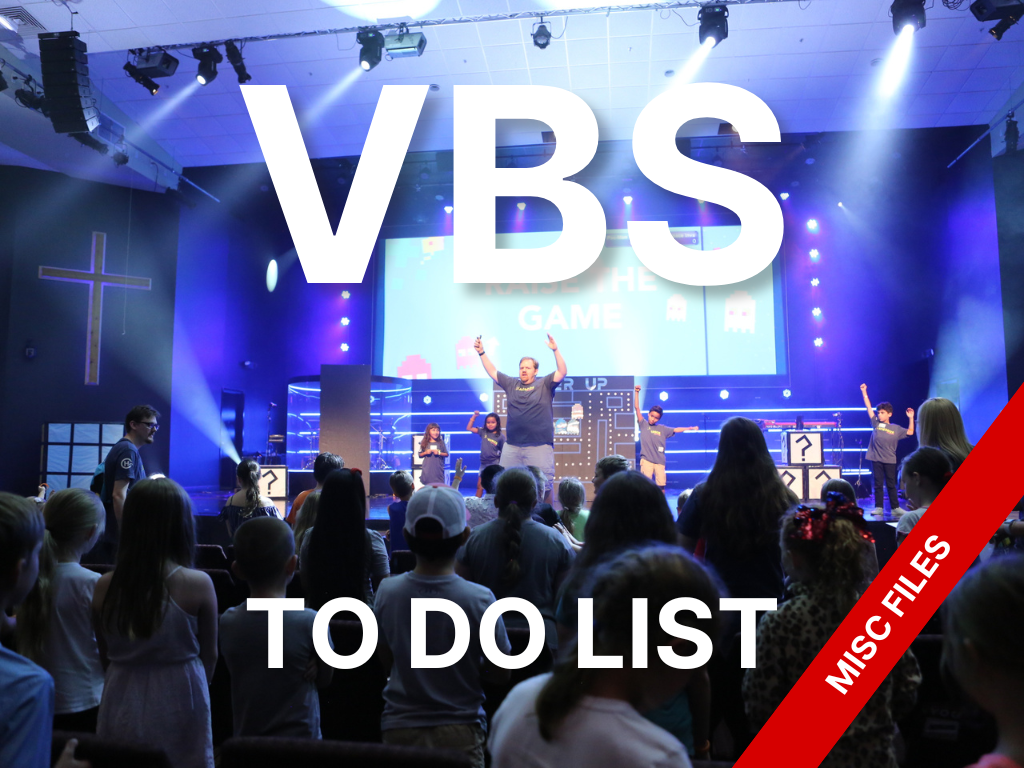3 Questions to Declutter Your Ministry Closet
Image from the DIY Playbook
There’s one ministry duty that we all have to do that no one really talks about. Everyone at the church knows about it, but no one wants to do anything about it. Then in staff meeting, the leader makes the announcement. It’s time to clean out that closet.
You know that closet I’m talking about. It’s the one that everyone uses, no one owns, you can’t walk in, and you’re scared of what might be growing in there. Somehow these announcements always come up during the summer. You may have a thousand excuses as to why you can't do it this week, but the truth remains. You need to clean it out.
The problem is that so many kidmin leaders and pastors in general are packrats or hoarders. I’m a recovering one myself. My drawers, shelves, and closets were chock full of stuff I “might” use in the future. (I’m still a digital hoarder, but we’re not here to talk about that. And yes, I do need that email from 2005. Leave me alone!)
The truth is that we are stewards of everything in the church. People gave their money to God and you or someone with buying power made the decision to spend that money. It’s our job to take care of it. We may not want to clean out that closet, but if you want to honor God and the people who made it possible, you need to.
The hardest part of cleaning out that closet is deciding what to get rid of. I’ve worked with leaders who want to hold on to everything and others who want to throw it all away. I don’t think either is healthy, helpful, or a good steward. Instead, I use a 3 question matrix to figure out what to keep and what to say goodbye to.
3 Questions to decide how to say goodbye to your stuff.
1. Have I used this in the last year for its intended purpose?
This first question is crucial and usually the easiest to answer. If you’ve used it in the last year, then there’s a good chance that you’re going to use it again. You should keep it. However, our closets are full of décor, costumes, props, crafts, and God knows what else. Most likely you haven’t used all that stuff in the last year. In fact, you probably haven’t used it in the last 5. Is it doing you any good gathering dust and taking up valuable shelf space? Is it time to let it go?
The last closet I cleaned out had a nice desk in it. They bought it for a future staff member for a good price. But, that staff member hasn’t materialized yet and there are two other unused desks. When I presented the question, other people pointed out that the desk has been used. As a catch all. That’s not it’s intended purpose. We should say goodbye. But before you do say goodbye ask the next question.
2. Do I intend to use this in the next year?
If the answer to the first question is no, then this next question should help. If you’re not planning to use it in the next year, you probably shouldn’t hold on to it. This stuff is taking up valuable shelf space that could be used for something else you really need.
At one church I served, the kids used to do big Christmas musicals. Year after year, they used these large triangular set pieces on wheels. As the scenes changed, you could rotate the piece without having to move everything out and back on. It was a really cool design. But the last musical was 5 years before. In addition, I wasn’t planning on doing anything that elaborate for years to come, if ever. I decided it was time to say goodbye.
Other leaders who’d seen them in action protested, but they couldn’t argue with the truth. The reason they wanted to keep them was for sentimental value. I’m all for sentiment. (Remember recovering packrat here.) But sometimes you just have to Marie Kondo the thing. Thank it for its service and send it to the dumpster.
3. If I was to get rid of this how difficult or expensive would it be to replace?
With this question you could make the argument that I should have kept the set pieces. They were unique and expensive. If I did decide to do a musical again, they would have been cool to have. There are some things in your ministry closets that you should keep just because they’d be hard to replace.
At another church I served, we found a 48-Star American flag. Had we used it in the last year? No. Do we plan to use it in the next year? No. Would it be difficult to replace? Yes! I took that thing out of its dusty corner and put it in a place of honor. This is a piece of American and our church’s history. There was no way I was going to throw that away.
While that flag was a once in a lifetime find, there are other things you should hold on to. Small things that hold sentimental value and can be placed prominently. Large things that are discontinued, but still serve a purpose. Overhead projector, anyone?
But, don’t get stuck in the sunk cost fallacy. People won't want to get rid of something because X amount of dollars was spent on it 10 years ago. We shouldn’t let it go. At one church, we had really nice mahogany dining room chairs lining the back of the fellowship hall. They looked like thrones and completely out of place in a room full of metal chairs and plastic tables. They were crazy expensive, and a member of the church donated them years before. When I asked why we still had them, the only answer I received was that they were mahogany.
I’m not furniture or wood guy, so I assume that’s good. But it doesn’t answer the question. Why do we have them? Why are they there? The chairs were caught in the sunk cost fallacy. They didn’t match the look we had. They were comically big and took up too much space. But because they were worth a lot, we couldn’t let them go. That’s not a good reason.
The Clean Sweep Protocol
So, when you’re cleaning out your closet, how do you sort all this stuff to make sure you don’t keep something you shouldn’t? How do you make sure you don't get rid of something you should keep?
I like to use the Clean Sweep protocol. It’s from an old TLC reality show called Clean Sweep. These expert cleaners would show up to people’s houses and help them make a room livable again. Think hoarders, but without all the cats. The hosts challenge the homeowners to place all their stuff in three piles. Keep, Sell, Toss. If they couldn’t sell the stuff then they gave it away. I used a modified version, keep, give, toss.
After asking the three questions, place your items in those three categories. You can move things back and forth but when you’re done, look at how much stuff you have and how much you’re keeping. It makes the work much more manageable.
As you put stuff back, everything needs to have a place. This is a great time to get that super organized person who has a monogrammed label maker. You’ll make their day. Label your bins and fill your shelves by categories. Then, you can find everything a whole lot faster. Your closet will be a useable again and not that dark place that no one wants to go.
Don’t be afraid to sell stuff, but put a timeline on it. List it while you’re cleaning and get it out in the next day or two. We all know those people who’ve driven around with a bag of clothes to give to the Salvation Army for a month. (Me)
Don’t be that person.
Take the stuff and give it away. That day. Throw it away. That day. You’re not done until everything is in it’s place, whether that’s a shelf, a donation center, or the dumpster.
Cleaning out your closets in ministry can be a nightmare. But it must be done to steward the resources God has entrusted you with. Every week, you take people’s tithe money that they gave to God to buy resources for the ministry. It’s our job as leaders and pastors to use the money wisely and take care of the things we’ve been entrusted with. Use these questions and the Clean Sweep protocol and in a few hours, you’ll be done. You’ll feel like you just stepped out of a nice, hot shower. Fresh and clean.
What’s the craziest thing you’ve found cleaning out a ministry closet?







Your volunteers are the greatest asset to your VBS. You need to give them all the tools to be successful. With this template, you’ll have all the tools you need to show them what to expect and what’s expected.